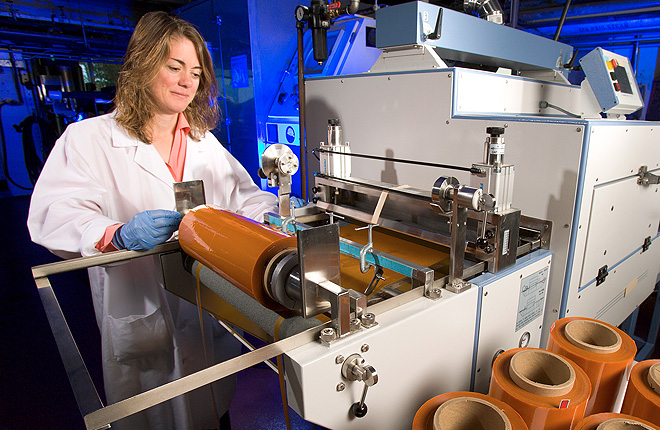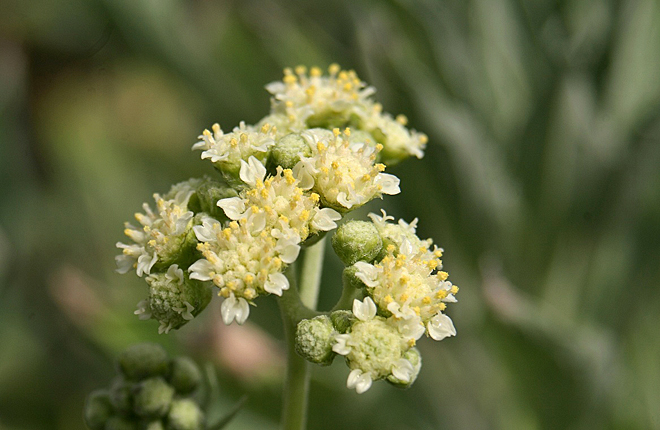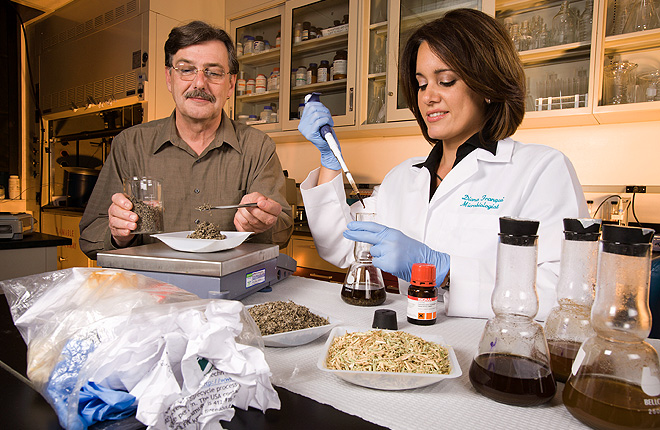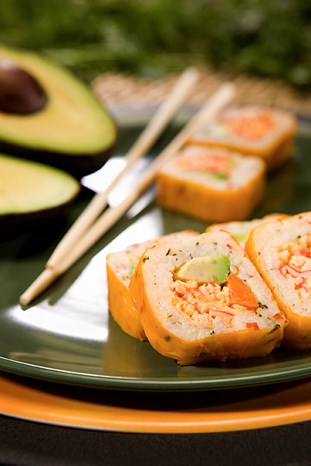Bioproducts for Food, Fuel, and Rubber
“Waste not, want not” is an age-old saying that is taken seriously in agricultural circles. In the bioproducts field, waste from food production or processing is the starting point to create value-added products.
Unmarketable Produce Finds New Life
|
|
Each year, $15 billion of American produce is wasted for a variety of reasons, including perceived imperfections and financial concerns. Food technologist Tara McHugh and her team at the Agricultural Research Service (ARS) Healthy Processed Foods Research Unit in Albany, California, find ways to turn unmarketable fruits and vegetables into new food products. Be it strawberries and apples or the leftovers from brewing beer, McHugh and her colleagues find uses for foods that would otherwise be thrown away.
Many fruits are too small or misshapen to be sent to market. McHugh and her colleagues found that these fruits and some vegetables can be processed into purees and made into snack bars. Thin sheets made from the purees can be used as healthy snacks or gluten-free wraps.
“Our new focus is to make these products with less energy. Infrared technology has been used to dry tree nuts, which has improved product quality and safety. It can also reduce energy use in making fruit- and vegetable-based healthy snacks,” says McHugh. “In applying the method to fruits and vegetables, we will measure energy consumption and product quality, and we’ll determine optimal processing conditions.”
Grapeseed Flour May Improve Health
California is known as wine country, but for every two bottles of wine made, one bottle of waste is produced. This waste includes the grapes’ stems, seeds, and skins. These byproducts contain nutrients, however, and can be used to make other products. Grape seeds contain many healthful compounds, such as protein, lipids, carbohydrates, and antioxidants, and can be made into a flour.
Chemist Wally Yokoyama, on McHugh’s team at the research unit, explored the effect of grapeseed flour in the diet of laboratory mice.
“In obese mice, we found the grapeseed flour reduced blood cholesterol by 37 percent and abdominal fat by 35 percent,” says Yokoyama. “We are beginning human clinical trials at the ARS Western Human Nutrition Research Center, in Davis, California, led by chemist Nancy Keim, to find out if the same thing happens to people.”
From Trash to Biofuels
In efforts to lessen our dependence on imported petroleum, scientists are looking for other ways to create fuel. Bill Orts and his colleagues at the ARS Bioproducts Research Unit in Albany, California, are conducting a pilot project at the Crazy Horse Sanitary Landfill in Salinas, California, to convert municipal solid waste (MSW)—household waste—into biomethane and ethanol, which can be used in place of diesel fuel in trucks or generators. Another benefit is to keep the waste out of landfills. “The active lifetime of the landfill would be greatly extended, and fewer landfills would be needed in the future,” says Orts.
Other project partners include the Salinas Valley Solid Waste Authority (SVSWA) and the Joint BioEnergy Institute.
Upon arrival at the landfill, MSW is loaded into autoclaves—large, closed cylinders that can pressure-treat using hot water for about 30 minutes. The autoclaving step is a pretreatment process that renders the solid wastes and food products into a slurry. The resulting mass is then passed through a screen to separate out organic components—like orange peels, egg shells, and paper products—from the remaining wastes, like metal cans and bottles that can be recycled. This process is called trommelling.
The U.S. Department of Agriculture (USDA), along with SVSWA, has been operating a pilot-scale test autoclave system to increase the efficiency of both methane and ethanol production from the pulp separated via trommelling. “Yields are roughly 70 gallons of ethanol per ton of MSW,” says Orts.
“Domestically, if all of the cellulose available from MSW were diverted into ethanol, it could provide roughly 18 percent of U.S. transportation fuel. This technology is just one step toward providing alternatives to petroleum by adding value to a waste stream,” says Orts. “Autoclaving MSW provides inexpensive cellulose-rich biomass for bioenergy processes that are already in use by the industry. Agricultural biomass can be added to this feedstock when seasonally available.”
Economics is a major consideration in bringing technologies to usefulness. The first economic benefit of this process is diversion of nearly all of the organics from landfill operations. Average landfill costs (tipping fees), especially in the western states, have surpassed $40/ton, and these costs are trending upward, according to Orts.
From Shrub to Rubber
Rubber is usually thought of as a substance made from petroleum or from rubber trees grown in Asia. But rubber can be also produced from a U.S. domestic plant called guayule. Guayule is a woody desert shrub cultivated in the southwestern United States as a source of natural rubber (latex), organic resins, and high-energy biofuel feedstock from crop residue.
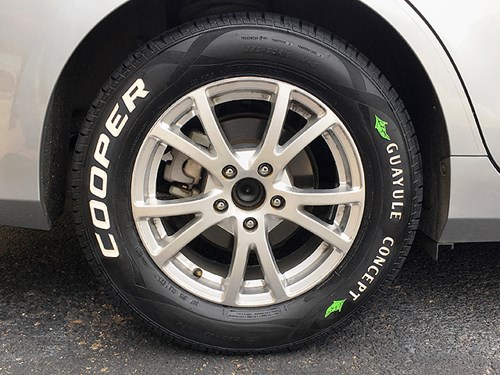 Cooper Tires has manufactured a demo tire made from guayule-derived rubber. (Colleen McMahan, D3924-1) |
ARS chemist Colleen McMahan and her lab colleagues, molecular biologists Grisel Ponciano, Niu Dong, and Dante Placido, and technician Trinh Huynh, in Albany, California, developed improved guayule for rubber production. In 2017, about 3,200 experimental guayule plants were delivered to Bridgestone Americas in Eloy, Arizona, for field testing.
“About 3 years ago, Bridgestone purchased 180 acres in Arizona and set up a state-of-the-art facility dedicated to developing guayule as a U.S. source of natural rubber,” says McMahan. At that time, Bridgestone Americas and ARS’s Bioproducts Research Unit entered into a research agreement to evaluate ARS genetically modified guayule that might provide increased yield.
“The genetic modification dramatically increased rubber content in the lab, and in partnership with Bridgestone, we will test if that translates to field conditions,” says McMahan.
This research technology demonstrated that a modern passenger tire can be made from U.S.-grown guayule natural rubber. Another partner, Cooper Tires, manufactured a demo tire, according to McMahan. In 2017, the group completed work under a 5-year USDA National Institute of Food and Agriculture (NIFA) awarded grant which was led by Cooper Tires, with significant ARS involvement.
“ARS did genome sequencing for guayule, rubber biochemistry studies, and agronomics work, including a major irrigation study,” says McMahan. “In 2017, another NIFA grant was awarded for work on guayule and guar. This one, led by the University of Arizona, is just starting. ARS scientists in Maricopa, Arizona, will be doing germplasm phenotyping, and our lab will be doing crop improvement.”
The tires have passed testing required by the U.S. Department of Transportation and more stringent internal industry tests. Guayule-rubber tires, with exceptional performance, have been established as meeting consumer requirements for a biobased rubber tire.
“Unfortunately, the supply of guayule-derived rubber is still limited, and we continue to focus on improving the yield of rubber from guayule and on sustainability,” says McMahan. “You need about 4 mature plants to yield enough rubber for a passenger tire, so with current yields, you can get about 500 guayule tires per acre. Both of those figures assume 100-percent guayule tires, which is unlikely. Commercialization would probably proceed with a lower percentage of guayule, which could get 1,000 tires per acre.”
Each of these sectors of bioproducing—food, fuel, and rubber products—aims to improve consumers’ future by adding healthy foods and reducing our dependence on petroleum.—By Sharon Durham, ARS Office of Communications.
Key Facts
- $15 billion of American produce is wasted.
- ARS develops new products from agricultural and municipal waste.
- The bioprocessing industry benefits the economy and the environment.
Full Story







